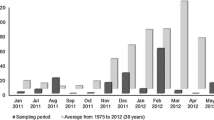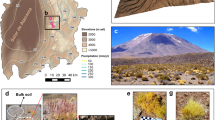Abstract
The nature reserve of Tehuacan-Cuicatlan in central Mexico is known for its diversity and endemism mainly in cactus plants. Although the xerophytic flora is reasonably documented, the bacterial communities associated with these species have been largely neglected. We assessed the diversity and composition of bacterial communities in bulk (non-rhizospheric) soil and the rhizosphere of three cactus plant species: Mammillaria carnea, Opuntia pilifera and Stenocereus stellatus, approached using cultivation and molecular techniques, considering the possible effect of dry and rainy seasons. Cultivation-dependent methods were focused on putative N2-fixers and heterotrophic aerobic bacteria, in the two media tested the values obtained for dry season samples grouped together regardless of the sample type (rhizospheric or non-rhizospheric), these groups also included the non-rhizospheric sample for rainy season, on each medium. These CFU values were smaller and significantly different from those obtained on rhizospheric samples from rainy season. Genera composition among isolates of the rhizospheric samples was very similar for each season, the most abundant taxa being α-Proteobacteria, Actinobacteria and Firmicutes. Interestingly, the genus Ochrobactrum was highly represented among rhizospheric samples, when cultured in N-free medium. The structure of the bacterial communities was approached with molecular techniques targeting partial 16S rRNA sequences such as denaturing gradient gel electrophoresis and serial analysis of ribosomal sequence tags. Under these approaches, the most represented bacterial phyla were Actinobacteria, Proteobacteria and Acidobacteria. The first two were also highly represented when using isolation techniques.




Similar content being viewed by others
References
Bachar A, Al-Ashhab A, Soares MI, Sklarz MY, Angel R, Ungar ED, Gillor O (2010) Soil microbial abundance and diversity along a low precipitation gradient. Microb Ecol 60:453–461
Bais HP, Weir TL, Perry LG, Gilroy S, Vivanco JM (2006) The role of root exudates in rhizosphere interactions with plants and other organisms. Annu Rev Plant Biol 57:234–266
Bashan Y, Rojas A, Puente ME (1999) Improved establishment and development of three cacti species inoculated with Azospirillum brasiliense transplanted into disturbed urban desert soil. Can J Microbiol 45:441–451
Berg G, Smalla K (2009) Plant species and soil type cooperatively shape the structure and function of microbial communities in the rhizosphere. FEMS Microbiol Ecol 68:1–13
Caballero JM, Onofre J, de los Santos P, Martinez L (2007) The tomato rhizosphere, an environment rich in nitrogen-fixing burkholderia species with capabilities of interest for agriculture and bioremediation. Appl Environ Microbiol 73:5308–5319
Carrillo-García A, Bashan Y, Díaz-Rivera E, Bethlenfalvay GJ (2000) Effects of resource-islands soils, competition and inoculation with Azospirillum on survival and growth of Pachycereus pringlei, the giant cactus of the Sonoran desert. Restor Ecol 8:65–73
Casas A, Barbera G (2002). Mesoamerican domestication and diffusion. In: Park S Nobel (ed) Cacti: Biology and uses, University of California Press. USA, pp 143–162
Chakraborty U, Chakraborty BN, Basnet M, Chakraborty AP (2009) Evaluation of Ochrobactrum anthropi TRS-2 and its talc based formulation for enhancement of growth of tea plants and management of brown root rot disease. J Appl Microbiol 107:625–634
Chanal A, Chapon V, Benzerara K, Barakat M, Christen R, Achouak W, Barras F, Heulin T (2006) The desert of Tataouine: an extreme environment that hosts a wide diversity of microorganisms and radiotolerant bacteria. Environ Microbiol 8:514–525
Chun J, Lee JH, Jung Y, Kim M, Kim S, Kim BK, Lim YW (2007) EzTaxon: a web-based tool for the identification of prokaryotes based on 16S ribosomal RNA gene sequences. Int J Syst Evol Microbiol 57:2259–2261
Dávila P, Arizmendi M, Valiente-Banuet A, Villaseñor J, Casas A, Lira R (2002) Biological diversity in the Tehuacan-Cuicatlan valley. Mex Biodivrs Conserv 11:421–442
Enge K, Whiteford S (1989) The keepers of water and earth: Mexican rural social organization and irrigation, pp 179–222. University of Texas Press, Austin
Felsenstein J. (1993). Phylip (Phylogeny Inference Package) version 3.57c. Dept. of Genetics, University of Washington, Seattle. http://evolution.genetics.washington.edu/phylip.html
Felske A, Engelen B, Nübel U, Backhaus H (1996) Direct ribosome isolation from soil to extract bacterial rRNA for community analysis. Appl Environ Microbiol 62:4162–4167
Haichar FE, Marol C, Berge O, Rangel-Castro JI, Prosser JI, Balesdent J, Heulin T, Achouak W (2008) Plant host habitat and root exudates shape soil bacterial community structure. ISME J 2:1221–1230
Herman RP, Provencio K, Torrez R, Seager GM (1994) Seasonal and spatial population dynamics of the nitrogen-efficient guild in a desert Baja grassland. Appl Environ Microbiol 60:1160–1165
Holland S (2003) Analytic Rarefaction. http://www.uga.edu/strata/software/index.html
Huber T, Faulkner G, Hugenholtz P (2004) Bellerophon; a program to detect chimeric sequences in multiple sequence alignments. Bioinformatics 20:2317–2319
Instituto Nacional de Estadística, Geografía e Informática (2005) Carta Topográfica, 1:250,000. Oaxaca, E 14–9. (INEGI). www.inegi.org.mx
Jones K, Bangs D (1985) Nitrogen fixation by free living heterotrophic bacteria in oak forest: the effect of liming. Soil Biol Biochem 17:705–709
Kempers AJ (1974) Determination of sub-microquantities of ammonium and nitrates in soils with phenol, sodium nitroprusside and hypochlorite. Geoderma 12:201–206
Kumar S, Dudley J, Nei M, Tamura K (2008) MEGA: a biologist-centric software for evolutionary analysis of DNA and protein sequences. Brief Bioinform 9:299–306
Kysela DT, Palacios C, Sogin ML (2005) Serial analysis of V6 ribosomal sequence tags (SARST-V6): a method for efficient, high-throughput analysis of microbial community composition. Environ Microbiol 7:356–364
Lebuhn M, Achouak W, Schloter M, Berge O, Meier H, Barakat M, Hartmann A, Heulin T (2000) Taxonomic characterization of Ochrobactrum sp. isolates from soil samples and wheat roots, and description of Ochrobactrum tritici sp. nov. and Ochrobactrum grignonense sp. nov. Int J Syst Evol Microbiol 50:2207–2223
López-Galindo F, Muñoz-Iniestra D, Hernández-Moreno M, Soler-Aburto A, Castillo López MC, Hernández-Arzate I (2003) Análisis integral de la toposecuencia y su influencia en la distribución de la vegetación y la degradación del suelo en la subcuenca de Zapotitlán de las Salinas, Puebla. Boletín de la Sociedad Geológica Mexicana LVI, pp 19–41
Mnasri B, Tajini F, Trabelsi M, Aouani ME, Mhamdi R (2007) Rhizobium gallicum as an efficient symbiont for bean cultivation. Agron Sustain Dev 27:331–336
Muyzer G, Brinkhoff T, Nübel U, Santegoeds C, Schäfer H, Wawer C (1998) Denaturing Gradient Gel Electrophoresis (DGGE) in Microbial Ecology. Chap. 3.4.4. In: Akkermans ADL, van Elsas JD, de Bruijn FJ (eds) Molecular Microbial Ecology Manual. Kluwer Academic Publishers, Dordrecht, pp 1–27
Ngom A, Nakagawa Y, Sawada H, Tsukahara J, Wakabayashi S, Uchiumi T, Nuntagij A, Kotepong S, Suzuki A, Higashi S, Abe M (2004) A novel symbiotic nitrogen-fixing member of the Ochrobactrum clade isolated from root nodules of Acacia mangium. J Gen Appl Microbiol 50:17–27
Nunan N, Daniell TJ, Singh BK, Papert A, McNicol JW, Prosser JI (2005) Links between plant and rhizoplane bacterial communities in grassland soils, characterized using molecular techniques. Appl Environ Microbiol 71:6784–6792
Príncipe A, Alvarez F, Castro MG, Zachi L, Fischer SE, Mori GB, Jofr E (2007) Biocontrol and PGPR features in native strains isolated from saline soils of Argentina. Curr Microbiol 55:314–322
Puente ME, Bashan Y (1993) Effect of inoculation with Azospirillum brasilense strains on the germination and seedlings growth of the giant columnar Cardon cactus (Pachycereus pringlei). Symbiosis 15:49–60
Puente ME, Ching Li Y, Bashan Y (2009) Rock-degrading endophytic bacteria in cacti. Environ Exp Bot 66:389–401
Ramírez-Saad H, Akkermans W, Akkermans ADL (1996) DNA Extraction from Actinorhizal Nodules. Chap. 1.4.4. In: Manual Molecular Microbial Ecology, Akkermans ADL, van Elsas JD, de Bruijn F (eds) Kluwer Academic Publishers. The Netherlands, Dordrecht, pp 1–11
Ramírez-Saad HC, Janse J, Akkermans ADL (1998) Root nodules of Ceanothus caeruleus contain both the N2-fixing Frankia endophyte and a phylogenetically related Nod-/Fix-actinomycete. Can J Microbiol 44:140–148
Ramírez-Saad HC, Sessitsch A, de Vos WM, Akkermans ADL (2000) Bacterial community changes and enrichment of uncultured Burkholderia-like bacteria induced by chlorinated benzoates in a Peat-forest soil-microcosm. Syst Appl Microbiol 23:591–598
Recagno E (2001) Conocimiento y conservación de las Mamilarias endémicas del valle de Tehuacán-Cuicatlán. Informe de Proyecto R166, CONABIO, Mexico pp 3–7
Rennie RJ (1981) A single medium for the isolation of acetylene reducing (dinitrogen fixing) bacteria from soil. Can J Microbiol 27:8–14
Ros M, Pascual JA, Moreno JL, Hernandez MT, Garcia C (2009) Evaluation of microbial community activity, abundance and structure in a semiarid soil under cadmium pollution at laboratory level. Water Air Soil Pollut 203:229–242
Rosselló-Mora R, Aman R (2001) The species concept for prokaryotes. FEMS Microbiol Rev 25:39–67
Rzedowski J (1991) Diversidad y orígenes de la flora fanerogámica de México. Acta Bot Mex 14:3–21
Sanguinetti CJ, Dias Nieto E, Simpson AJG (1994) Rapid silver staning and recovery of PCR products separated on polyacrilamyde gels. Biotechniques 17:915–919
Schloss PD, Larget BR, Handelsman J (2004) Integration of microbial ecology and statistics: a test to compare gene libraries. Appl Environ Microbiol 70:5485–5492
Singleton DR, Furlong MA, Rathbun SL, Whitman WB (2001) Quantitative comparison of 16S rRNA gene sequence libraries from enviromental samples. Appl Environ Microbiol 67:4374–4376
Sliwinski MK, Goodman RM (2003) Comparison of Crenarchaeal consortia inhabiting the rhizosphere of diverse terrestrial plants with those in bulk soil in native environments. Appl Environ Microbiol 70:1821–1826
Smalla K, Wieland G, Buchner A, Zock A, Parzy J, Kaiser S, Roskot N, Heuer H, Berg G (2001) Bulk and rhizosphere soil bacterial communities studied by denaturing gradient gel electrophoresis: plant-dependent enrichment and seasonal shifts revealed. Appl Environ Microbiol 67:4742–4751
Somers E, Vanderleyden J, Srinivisam M (2004) Rhizosphere bacterial signaling: a love parade beneath our feet. Crit Rev Microbiol 30:205–240
Stotzky G (1997) Soil as an Environment for Microbial Life. In: Van Elsas JD, Trevors JT, Wellington EMH (eds) Modern Soil Microbiology, pp 1–20. Marcel Dekker Inc, New York
Tripathi AK, Verma SC, Chowdhury SP, Lebuhn M, Gattinger A, Schloter M (2006) Ochrobactrum oryzae sp. nov., an endophytic bacterial species isolated from deep-water rice in India. Int J Syst Evol Microbiol 56:1677–1680
Trubat R, Cortina J, Vilagrosa A (2010) Nursery fertilization affects seedling traits but not field performance in Quercus suber L. J Arid Environ 74:491–497
Trujillo ME, Willems A, Abril A, Planchuelo AM, Rivas R, Ludeña D, Mateos PF, Martínez-Molina E, Velázquez E (2005) Nodulation of Lupinus albus by strains of Ochrobactrum lupini sp. nov. Appl Environ Microbiol 71:1318–1327
Yechieli A, Oren A, Yair A (1995) The effect of water distribution on bacterial numbers and microbial activity along a hill slope, northern Negev. Isr Adv Geoecol 28:193–207
Zhang Z, Schwartz S, Wagner L, Miller W (2000) A greedy algorithm for aligning DNA sequences. J Comput Biol 7:203–214
Zurdo-Piñeiro JL, Rivas R, Trujillo ME, Vizcaíno N, Carrasco JA, Chamber M, Palomares A, Mateos PF, Martínez-Molina E, Velázquez E (2007) Ochrobactrum cytisi sp. nov., isolated from nodules of Cytisus scoparius in Spain. Int J Syst Evol Microbiol 57:784–788
Acknowledgments
This work received financial support from Foundation BBVA, trough project BIOCON 04-084. F.A.G. received fellowships from CONACyT and COMECyT (Mexico), for PhD studies.
Author information
Authors and Affiliations
Corresponding author
Rights and permissions
About this article
Cite this article
Aguirre-Garrido, J.F., Montiel-Lugo, D., Hernández-Rodríguez, C. et al. Bacterial community structure in the rhizosphere of three cactus species from semi-arid highlands in central Mexico. Antonie van Leeuwenhoek 101, 891–904 (2012). https://doi.org/10.1007/s10482-012-9705-3
Received:
Accepted:
Published:
Issue Date:
DOI: https://doi.org/10.1007/s10482-012-9705-3




